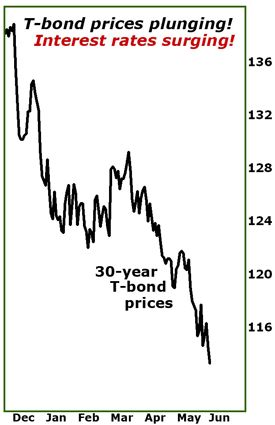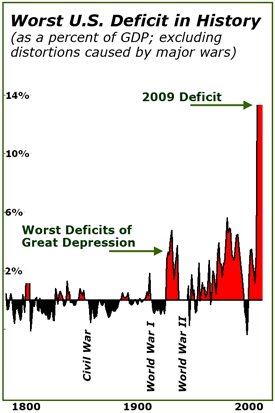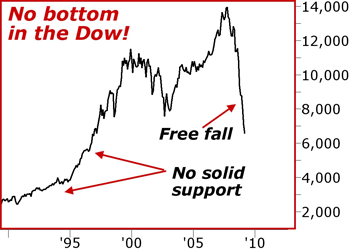U.S. Debt Crisis as Treasury Bond Prices Collapsing and Interest Rates Surging
Interest-Rates / US Debt Jun 08, 2009 - 09:01 AM GMT Martin Weiss writes: Just as we’ve been warning, the United States Treasury is the next and largest victim of this great debt crisis.
Martin Weiss writes: Just as we’ve been warning, the United States Treasury is the next and largest victim of this great debt crisis.
Right now, the Treasury’s finances are collapsing … its bond prices plunging … its interest rates surging.
Indeed, the Treasury’s financial crisis looms so large, it could wreck more havoc on the economy and deliver more pain to average Americans than the subprime mortgage disaster, the housing bust, the banking crisis, and the collapse of General Motors put together …
It could create a rising tide of interest rates that wipes out the effects of any stimulus, undermines any recovery, and sabotages any new bailouts …
But unlike GM, Fannie Mae, Citigroup, AIG, and the many others that the U.S. Treasury has bailed out in recent months, there is no institution on the planet big or rich enough to bail out the U.S. Treasury itself.
Further, unlike all prior episodes in this great debt crisis, the Treasury’s financial troubles cannot be covered up, papered over, or kicked down the road like an empty tin can.
 |
Already, Treasury bond prices are crashing, and doing so with greater speed that at any time in history.
Already, interest rates, which automatically go up when bond prices fall, are surging, with the rate on 10-year U.S. Treasuries nearly DOUBLING in a half year — the most dramatic surge during any recession since the founding of the Republic.
And already, the interest rates on 30-year fixed mortgages, auto loans, commercial loans, and other debt are going through the roof.
This Is a Game Changer!
If you’re not paying attention to this new phase of the debt crisis, you’re making a grave error. And if you’re not taking swift action to protect yourself, you’re taking your financial life in your hands.
In this issue, I’ll show why it’s going to get worse, why the Federal Reserve is powerless to stop it, how it will impact each major sector of the economy, and what you must do immediately to protect yourself and your family from the inevitable fallout.
Why This Is Just the Beginning of the Treasury’s Crisis. Why It’s Going to Get a Heck of a Lot Worse This Year. And Why It Could Continue for Years Beyond 2009.
It’s widely known that America’s federal deficit is out of control.
But so many dire deficit warnings have been issued so often, they now fall mostly on deaf ears. Wall Street pundits roll their eyes. Washington politicians laugh at those who would cry “wolf.”
What they don’t realize is that this time, due to a series of devastating facts they’ve chosen to ignore, the day of reckoning is here:
Fact #1. Sheer size. According to the government’s official estimate, the federal deficit for fiscal year 2009 will be $1.84 trillion, or 13.4 percent of GDP!*
It is the worst deficit in U.S. history.
It means the deficit has now exploded to a level which is so far beyond the range of anything we’ve experienced before, it’s impossible to imagine any scenario in which it does not have a devastating impact.
Fact #2. The actual deficit could be much larger. The administration’s $1.84 trillion deficit forecast presupposes a dramatic turnaround in the economy, which, by definition, is virtually impossible with the government running trillion-dollar deficits!
How can the administration possibly predict an economic turnaround when its own Treasury Department is sucking nearly $2 trillion in funds out of credit markets — the same credit markets that derailed the economy late last year?
Similarly, how can the government predict a turnaround when its own borrowing frenzy is already driving up mortgage rates and undermining real estate, the one sector that’s most responsible for the economy’s decline in the first place?
Fact #3. No end in sight. Since the United States declared its independence nearly 233 years ago, the only time the federal deficit approached or exceeded 10 percent of GDP was during major wars — the Civil War, World War I, and World War II. But in each case, the deficit financing began promptly — and ended promptly — with the war.
Unfortunately, that’s not the case this time. Although the U.S. is fighting wars in Iraq and Afghanistan, their cost represents only a small fraction of the budget shortfall. Even if the Iraqi and Afghan wars could be ended tomorrow, America’s great budget crisis would still be just beginning.
 |
Fact #4. Today’s deficits are far worse than those of the Great Depression. America’s first big, multi-year peacetime deficits came in the 1930s. Tax revenues plunged with the sinking economy. And in the years that ensued, government expenditures — mostly for a series of programs to bail out the economy — went through the roof.
But even with a 90 percent collapse in the stock market in 1929-32 and even after three years of double-digit GDP declines that make today’s look mild by comparison, the federal deficit in 1933 was just 3.27 percent of GDP, less than one-fourth of what’s projected for this year.
And subsequently, even when the U.S. government embarked on the most ambitious stimulus and bailout programs of its 150-year history, the biggest single deficit — in 1936 — was 4.76 percent of GDP, only about one-third the size of today’s.
Fact #5. Structural deficits. Our nation’s second encounter with giant peacetime deficits was in the 1980s, but with a big difference: This time, there was no Great Depression. This time, the government’s fiscal woes were mostly structural — deeply ingrained in the bloated size of government and in our society’s dependence on government for much of its sustenance.
And even then, the federal deficit never rose to more than 5.63 percent of GDP, less than HALF its size today.
The big difference today: Our current structural deficits are far larger than in the 1980s because the government is now liable for $65 trillion in future payments for Social Security, Medicare, government pension benefits, and other obligations that are now kicking in at a quickening pace.
Fact #6. Massive new commitments. Beyond the $1.84 trillion of red ink projected for 2009 and beyond the trillions more in future obligations, the U.S. government has just assumed responsibility for nearly $14 trillion in new loans, commitments, and guarantees to bail out brokers, banks, insurers, auto makers, and the broader economy.
If just one of these suffers greater-than-expected losses, we could see wave after wave of new demands on the government to honor its guarantees, bloating the deficit far further.
Why the Federal Reserve Can’t Stop Treasury Bonds from Falling
I can assure you, it’s not for lack of trying.
In a massive attempt to boost Treasury bond prices launched March 25, the Fed has now bought $145.5 billion in Treasury notes and bonds, the most ever in such a short period of time. But despite all the Fed’s buying, T-bond prices have continued to plunge and interest rates have continued to surge.
Plus, in an even larger effort to support mortgage prices — and to suppress mortgage rates — the Fed has poured a whopping $507 billion into direct purchases of mortgage-backed securities (MBSs). But again, even after spending more than a half trillion dollars to bid them up, mortgage prices have still collapsed and rates have still surged.
In sum, the U.S. Federal Reserve has failed to stop this new phase of the crisis, and one of the key reasons is obvious:
To buy bonds, the Fed must print money. But the more it prints, the more it fans inflation fears and the more it chases away bond investors, who realize they’ll be paid back in cheaper dollars.
Some pundits seem to think the Fed can simply print all the money it wants to finance the massive deficits. But in the real world, it doesn’t work that way.
The reason: As I explained last week, the government has not one, but TWO debt problems simultaneously:
A. The NEW debt problem:Massive Treasury borrowings of close to $2 trillion just to fill the gaping holes in the current federal budget.
B. The OLD debt problem: $14.5 trillion in Treasury securities, government agency securities, and MBSs outstanding.
The problem: If just 10 percent of those are dumped on the market, it would trigger the sale of $1.45 trillion worth, easily overwhelming the Fed’s purchases.
The dilemma: The main reasons investors sell — fear of inflation and damage to the U.S. government’s credit — are, themselves, fueled by the Fed’s money printing and bond buying.
End result: The more the Fed buys bonds, the more it risks triggering massive investor selling.
So if you’re counting on the Federal Reserve to bail out the U.S. Treasury Department, forget it.
In the government’s grand balance sheet, printing money does nothing more than shift debts from one government account to another. It does not create wealth. It certainly does not stop bond prices from plunging and interest rates from surging.
Far-Reaching Consequences
Never underestimate the impact of surging rates — especially with near double-digit official unemployment and the worst debt crisis since the Great Depression.
Rising rates in this environment will be pure poison for:
- The nation’s insurance companies loaded with long-term corporate and government bonds.
- The nation’s banks counting on low interest rates to raise funds for close to nothing.
- Utilities that must continually borrow huge amounts of long-term money to finance their massive investments in power plants and facilities.
- Home prices that can only fall when available credit in the nation is hogged by Uncle Sam’s massive borrowing and when mortgage rates rise.
- You! Stocks, long-term bonds, and virtually all types of real estate properties are extremely vulnerable to surging interest rates.
Your Action Plan
FIRST: Get the heck away from long-term bonds and shift to shortest term securities.
SECOND: Use the resources provided with my new book, The Ultimate Depression Survival Guide, to find a truly safe bank near you … or to bypass banks entirely.
THIRD: Use any temporary market recoveries as an opportunity to SELL off assets you don’t need, such as investment real estate and vulnerable stocks. Keep your 401(k). But within your 401(k), shift to the safest, shortest term alternative available.
FOURTH: To profit from falling bond prices, consider inverse ETFs designed to rise as Treasury bonds fall.
Good luck and God bless!
Martin
* The 13.4 percent of GDP assumes the following: Deficit — the $1.84 trillion projected by the administration; GDP — the 3.3 percent GDP decline proposed by the banking regulators in their bank stress tests. However, the actual deficit in that scenario could be larger.
This investment news is brought to you by Money and Markets . Money and Markets is a free daily investment newsletter from Martin D. Weiss and Weiss Research analysts offering the latest investing news and financial insights for the stock market, including tips and advice on investing in gold, energy and oil. Dr. Weiss is a leader in the fields of investing, interest rates, financial safety and economic forecasting. To view archives or subscribe, visit http://www.moneyandmarkets.com .
Money and Markets Archive |
© 2005-2022 http://www.MarketOracle.co.uk - The Market Oracle is a FREE Daily Financial Markets Analysis & Forecasting online publication.
Comments
|
William Feader
14 Jun 09, 05:25 |
Accountability
This is the same Martin Weiss, who, just 6 months ago was advising investors to cash in all their stocks and bonds, no matter what loss they would take, and BUY US treasuries on the premise that if the great collapse occurred, the Treasuries could always be used for money. Sorry, but I just don't buy what this guy says anymore. |
|
TraderJoe
14 Jun 09, 06:13 |
Martin Weiss calls
Yeh this is what Weiss wrote as stocks bottomed in March - http://www.marketoracle.co.uk/Article9349.html
|




